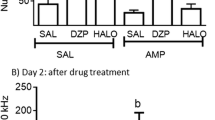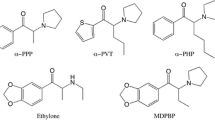Abstract
The objective of the present experiments was to characterize psychomotor stimulant effects ofd-amphetamine, methylenedioxymethamphetamine (MDMA) and phencyclidine (PCP) on conditioned performance and on aggressive behavior in mice. In a novel protocol with alternating periods of schedule-controlled responding and aggressive behavior toward an intruder it was possible to assess a range of species-specific agonistic acts, postures, and motor activities as well as response rates and patterns engendered by a multiple Fixed Interval (FI) and Fixed Ratio (FR) schedule within the same animal. Initially, it was confirmed thatd-amphetamine and, less reliably, MDMA and PCP, increased FI, but not FR responding in mice. In the next experiment, mice confronted an intruder at the midpoint of the 1-h daily session; following the display of aggressive behavior, the rate of FI responding showed an amphetamine-like increase, whereas only a transient change occurred after non-aggressive encounters. Thirdly, using this new protocol, PCP,d-amphetamine and MDMA altered FI and FR responding in a way that was closely similar to the first experiment. Low PCP andd-amphetamine doses increased aggressive behavior erratically in certain individuals, but not reliably for the group. MDMA dose-dependently decreased aggressive behavior, and all drugs disrupted aggressive behavior at higher doses. The characteristic increases in walking and decreases in rearing after higher doses of PCP andd-amphetamine were greatly attenuated when the intruder was present. The rate-increasing effects ofd-amphetamine, MDMA and PCP occurred in the early portion of the fixed interval when the control rate is typically low; by contrast, low attack rates during the later portion of the confrontation with the intruder remained unaffected. The dose-dependent quantitatively and qualitatively differentiated profile of effects on schedule-controlled responding, motor activity and aggressive behavior suggest that the common properties ofd-amphetamine, MDMA and PCP pertain mostly to the disruption of organized behavior patterns and activation of repetitive motor routines at high doses, but point to different mechanisms for modulating aggressive behavior and conditioned performance at lower doses.
Similar content being viewed by others
References
Balster RL (1987) The behavioral pharmacology of phencyclidine. In: Meltzer HY (ed) Psychopharmacology: the third generation of progress. Raven, New York, pp 1573–1579
Battaglia G, Yeh SY, De Souza EB (1988) MDMA-Induced neurotoxicity: parameters of degeneration and recovery of brain serotonin neurons. Pharmacol Biochem Behav 29:269–274
Blundell JE (1987) Structure, process, and mechanism: case studies in the psychopharmacology of feeding. In: Iversen LL, Iversen SD, Snyder SH (eds) Handbook of psychopharmacology, vol. 19: new directions in behavioral pharmacology. Plenum, New York, pp 123–182
Brain PF (1981) Differentiating types of attack and defense in rodents. In: Brain PF, Benton D (eds) Multidisciplinary approaches to aggression research. Elsevier, Amsterdam, pp 53–78
Burkhalter JE, Balster RL (1979) The effects of phencyclidine on isolation-induced aggression in mice. Psychol Rep 45:571–576
Cooper JR, Bloom FE, Roth RH (1991) The biochemical basis of neuropharmacology, 6th edn. Oxford University Press, New York
Dews PB, Wenger GR (1977) Rate-dependency of the behavioral effects of amphetamine. Advances in Behavioral Pharmacology 1:167–227
Glennon RA, Little PJ, Rosecrans JA, Yousif M (1987) The effect of MDMA (“Ecstasy”) and its optical isomers on schedule-controlled responding in mice. Pharmacol, Biochem Behav 26:425–426
Haney M, Miczek KA (1990) Aggression attenuates psychomotor stimulant effects ofd-amphetamine, MDMA and PCP. Pharmacol Biochem Behav 36:439
Haney M, Noda K, Kream R, Miczek KA (1990) Regional 5-HT and dopamine activity: sensitivity to amphetamine and aggressive behavior in mice. Aggress Behav 16:259–270
Hashimoto K, Goromaru T (1990) Reduction of in vivo binding of [3H]paroxetine in mouse brain by 3,4-methylenedioxymethamphetamine. Neuropharmacology 29:633–639
Johnson KM Jr (1987) Neurochemistry and neurophysiology of phencyclidine. In: Meltzer HY (ed) Psychopharmacology: the third generation of progress. Raven, New York, pp 1581–1588
Kantak KM, Miczek KA (1988) Social, motor, and autonomic signs of morphine withdrawal: differential sensitivities to catecholaminergic drugs in mice. Psychopharmacology 96:468–476
Krsiak M (1979) Effects of drugs on behaviour of aggressive mice. Br J Pharmacol 65:525–533
Kuczenski R (1983) Biochemical actions of amphetamine and other stimulants. In: Creese I (ed) Stimulants: neurochemical, behavioral, and clinical perspectives. Raven, New York, pp 31–61
Logan BJ, Laverty R, Sanderson WD, Yee YB (1988) Differences between rats and mice in MDMA (methylenedioxymethamphetamine) neurotoxicity. Eur J Pharmacol 152:227–234
Malick JB (1979) The pharmacology of isolation-induced aggressive behavior in mice. In: Essman WB, Valzelli L (eds) Current developments in psychopharmacology. New York, pp 1–27
McMillan DE (1969) Effects ofd-amphetamine on performance under several parameters of multiple fixed-ratio, fixed-interval schedules. J Pharmacol Exp Ther 167:26–33
Miczek KA (1979) A new test for aggression in rats without aversive stimulation: differential effects ofd-amphetamine and cocaine. Psychopharmacology 60:253–259
Miczek KA (1982) Ethological analysis of drug action on aggression, defense and defeat. In: Spiegelstein MY, Levy A (eds) Behavioral models and the analysis of drug action. Elsevier, Amsterdam, pp 225–239
Miczek KA (1987) The psychopharmacology of aggression. In: Iversen LL, Iversen SD, Snyder SH (eds) Handbook of psychopharmacology, vol. 19: new directions in behavioral pharmacology. Plenum, New York, pp 183–328
Miczek KA, DeBold JF, Haney M, Tidey J, Vivian J, Weerts E (1994) Neurochemistry and pharmacotherapeutic management of violence and aggression. In: Reis J, Miczek KA, Roth J (eds) Understanding and Preventing Violence, Vol. 2. National Academy Press, Washington DC (in press)
Miczek KA, Gold LH (1983)d-Amphetamine in squirrel monkeys of different social status: effects on social and agonistic behavior, locomotion, and stereotypies. Psychopharmacology 81:183–190
Miczek KA, O'Donnell JM (1978) Intruder-evoked aggression in isolated and nonisolated mice: effects of psychomotor stimulants andl-dopa. Psychopharmacology 57:47–55
Miczek KA, Tidey J (1989) Amphetamines: Aggressive and social behavior. In: Asghar K, DeSouza E. (eds) Pharmacology and toxicology of amphetamine and related designer drugs. National Institute on Drug Abuse Research Monograph No. 94. Superintendent of Documents, US Government Printing Office, Washington, DC, pp. 68–100
Miczek KA, Winslow JT (1987) Analgesia and decrement in operant performance in socially defeated mice: Selective cross-tolerance to morphine and antagonism by naltrexone. Psychopharmacology 92:444–451
Miczek KA, Yoshimura H (1982) Disruption of primate social behavior byd-amphetamine and cocaine: differential antagonism by antipsychotics. Psychopharmacology 76:163–171
Miczek KA, Haney M, Tidey J, Vatne T, Weerts E, DeBold JF (1989) Temporal and sequential patterns of agonistic behavior: effects of alcohol, anxiolytics and psychomotor stimulants. Psychopharmacology 97:149–151
Nader MA, Hoffmann SM, Barrett JE (1989) Behavioral effects of ± 3,4-methylenedioxyamphetamine (MDA) and ± 3,4-methylenedioxyamphetamine (MDMA) in the pigeon: Interactions with noradrenergic and serotonergic systems. Psychopharmacology 98:183–188
Puglisi-Allegra S, Cabib S (1990) Effects of defeat experiences on dopamine metabolism in different brain areas of the mouse. Aggress Behav 16:271–284
Rewerski WJ, Piechocki T, Rylski M (1973) Effects of hallucinogens on aggressiveness and thermoregulation in mice. In: Schonbaum E, Lomax P (eds) The Pharmacology of Thermoregulation. Karger, New York, pp 432–436
Ricaurte G A, Forno LS, Wilson MA, DeLanny LE, Irwin I, Molliver M, Langston JW (1988) (±)3,4-Methylenedioxymethamphetamine selectively damages central serotonergic neurons in nonhuman primates. JAMA 260:51–55
Robbins TW (1977) A critique of the methods available for the measurement of spontaneous motor activity. In: Iversen LL, Iversen SD, Snyder SH (eds) Handbook of Psychopharmacology, Vol. 7. Plenum Press, New York, pp 37–82
Robbins TW (1981) Behavioural determinants of drug action: ratedependency revisited. In: Cooper SJ (ed) Theory in psychopharmacology. Academic, New York, pp 1–63
Russel JW, Greenberg BD, Segal DS (1984) The effects of phencyclidine on spontaneous aggressive behavior in the rat. Biological Psychiatry 19:195–202
Schmidt CJ, Wu L, Lovenberg W (1986) Methylenedioxymethamphetamine: A potentially neurotoxic amphetamine analogue. European Journal of Pharmacology 124:175–178
Seiden LS, Sabol KE, Ricaurte GA (1993) Amphetamine: effects on catecholamine systems and behavior. Annu Rev Pharmacol Toxicol 32:639–677
Steele TD, Nichols DE, Yim GKW (1989) MDMA transiently alters biogenic amines and metabolites in mouse brain and heart. Pharmacol Biochem Behav 34:223–227
Stone DM, Stahl DC, Hanson GR, Gibb JW (1986) The effects of 3,4-methylenedioxymethamphetamine (MDMA) and 3,4-methylenedioxyamphetamine (MDA) on monoaminergic systems in the rat brain. Eur J Pharmacol 128:41–48
Stone DM, Johnson M, Hanson GR, Gibb JW (1988) Role of endogenous dopamine in the central serotonergic deficits induced by 3,4-methylenedioxymethamphetamine. J Pharmacol Exp Ther 247:79–87
Sulser F, Sanders-Bush E (1971) Effect of drugs on amines in the CNS. Annu Rev Pharmacol 11:209–230
Tidey JF, Miczek KA (1992a) Heightened aggressive behavior during morphine withdrawal: effects ofd-amphetamine. Psychopharmacology 107:297–302
Tidey JF, Miczek KA (1992b) Effects of SKF 38393 and quinpirole on patterns of aggressive, motor and schedule-controlled behaviors in mice. Behav Pharmacol 3:553–565
Tyler CB, Miczek KA (1982) Effects of phencyclidine on aggressive behavior in mice. Pharmacol Biochem Behav 17:503–510
Wenger GR, Dews PB (1976) The effects of phencyclidine, ketamine,d-amphetamine and pentobarbital on schedule-controlled behavior in the mouse. J Pharmacol Exp Ther 196:616–624
Wilmot CA, Vanderwende C, Spoerlein MT (1987) The effects of phencyclidine on fighting in differentially housed mice. Pharmacol Biochem Behav 28:341–346
Winslow JT, Miczek KA (1983) Habituation of aggression in mice: pharmacological evidence of catecholaminergic and serotonergic mediation. Psychopharmacology 81:286–291
Winslow JT, Miczek KA (1984) Habituation of aggressive behavior in mice: a parametric study. Aggress Behav 10:103–113
Author information
Authors and Affiliations
Rights and permissions
About this article
Cite this article
Miczek, K.A., Haney, M. Psychomotor stimulant effects ofd-amphetamine, MDMA and PCP: aggressive and schedule-controlled behavior in mice. Psychopharmacology 115, 358–365 (1994). https://doi.org/10.1007/BF02245077
Received:
Revised:
Issue Date:
DOI: https://doi.org/10.1007/BF02245077




